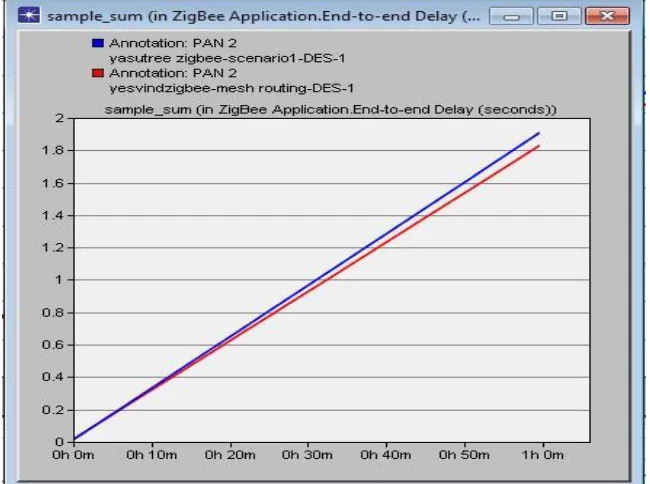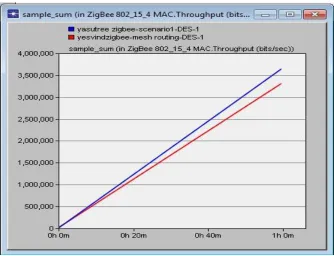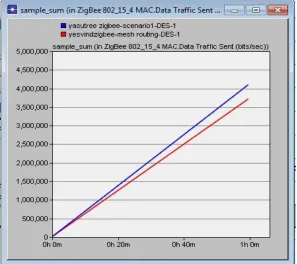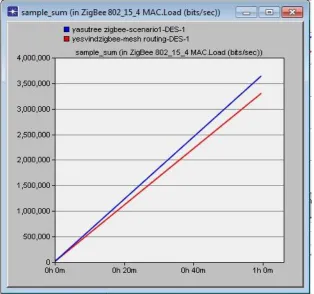Available Online atwww.ijcsmc.com
International Journal of Computer Science and Mobile Computing
A Monthly Journal of Computer Science and Information Technology
ISSN 2320–088X
IJCSMC, Vol. 3, Issue. 6, June 2014, pg.922 – 932
RESEARCH ARTICLE
IEEE 802.15.4 based Investigation and
Simulation Evaluation of ZigBee Tree and
Mesh Topology using Different QoS
Yasvindar Rana
1, Vikram Nandal
2, Kuldeep Vats
3, Ravinder Kumar
4 1 M.Tech, Department of CSE, RN College of Engineering, Rohtak, Haryana, Indiayashrana2009@gmail.com
2
Assistant Professor, Department of CSE, RN College of Engineering, Rohtak, Haryana, India
vickyna9@gmail.com
3B.E. (Honors), M.Tech, Department of Computer Science Engineering, Sonepat, Haryana, India
kuldeepvats@yahoo.com
4M.Tech, Department of CSE, RN College of Engineering, Rohtak, Haryana, India
.mr.ladwal@gmail.com
ABSTRACT- The IEEE 802.15.4 and ZigBee protocol stack offers a practical application solution for low cost, low data rate, and low energy consumption characteristics for Wireless Sensor Networks (WSN). The ZigBee networks facilitate many applications, such as Commercial Building and Home Automation, Security, Healthcare Medical Monitoring, Vehicle Monitoring, Agriculture and Environmental Monitoring and so on. Energy consumption, latency and reliability are critical performance measurements in most monitoring systems. This project focuses on simulation an IEEE 802.15.4 and ZigBee protocol using the OPNET simulator.
I. INTRODUCTION
Philips, Motorola, Honeywell, Invensys and Mitsubishi Electric started promoting ZigBee when they formed the ZigBee Alliance in October 2002. This was once they had secured the physical layer (PHY) and media access control (MAC) under the IEEE 802.15.4 WPAN (Wireless Personal Area Network) standard [10]. The technology has been living under various guises at Philips for four years. It started life as HomeRF Lite (a sub-spec of the defunct HomeRF, which has now been ousted by Wi-Fi). Since then, it’s had name changes to RF Lite, Firefly, RF EasyLink and finally, it became ZigBee [10]. The name comes from the zig-zag dancing of bees to tell the other bees in the colony of the location of a new food source. ZigBee is a worldwide open standard for wireless radio networks in the monitoring and control fields. The standard was developed by the ZigBee Alliance to meet the following principal needs [9]:
• Low cost
• Ultra-low power consumption • Low data rate (less than 250 Kbps) • Use of unlicensed radio bands • Cheap and easy installation • Flexible and easy installation
• Integrated intelligence for network set-up and message routing
Figure 1: A typical example of ZigBee in Home Automation [9]
The ZigBee standard can operate in the 2.4GHz band or the 868MHz and 915MHz ISM (industrial, scientific, and medical) bands used in Europe and the US respectively [10].
II. Architecture
digital data into output. A single device may run multiple applications to perform different tasks (i.e. reading temperature and humidity). The application layer is on top of another layer called the network layer (NWK). The network layer provides ZigBee functionality and acts as a buffer between application layer and data link layer (DLL). The network layer is responsible for network structure, routing, and security such as encryption, key management, and authentication. The data link layer is provided by IEEE 802.15.4 standard. This layer consists of two sub-layers – medium access control layer (MAC) and the physical layer (PHY).
Application layer (APL)
Network layer (NWK)
Medium access control layer (MAC)
Physical layer (PHY)
Table 1: ZigBee protocol layers
2.1. Device types
There are three different types of ZigBee devices:
• ZigBee coordinator (ZC):
The most capable device, the coordinator forms the root of the network tree and might bridge to other networks. There is exactly one ZigBee coordinator in each network since it is the device that started the network originally. It is able to store information about the network, including acting as the Trust Centre & repository for security keys.
• ZigBee Router (ZR):
As well as running an application function a router can act as an intermediate router, passing data from other devices.
• ZigBee End Device (ZED):
Contains just enough functionality to talk to the parent node (either the coordinator or a router); it cannot relay data from other devices. This relationship allows the node to be asleep a significant amount of the time thereby giving long battery life. A ZED requires the least amount of memory, and therefore can be less expensive to manufacture than a ZR or ZC [7].
2.2. Addressing
IEEE 802.15.4 uses two methods of addressing: • 16-bit short addressing
• 64-bit extended addressing
mechanism allows addressing within a single network; however, the combination of a unique PAN ID (personal area network identifier) and 16-bit addressing can be used to address independent networks. Alternatively, 64-bit addressing in IEEE 802.15.4 has not limitation on the number of devices in a single network.
The network layer (NWK) of ZigBee protocol uses a 16-bit address in addition to the IEEE address. The network layer data transactions require an NWK address. A lookup table is used to ap each IEEE 802.15.4 64-bit address to a unique network layer address [11].
III. Simulation Scenarios
There are two scenarios studied in this project. First, the three possible topologies (Star, Tree, and Mesh) are compared with each other. There is just one ZigBee coordinator in each topology, therefore it just forms a single personal area network (PAN). The comparison includes the statistics: end-to-end delay, number of hops, ZC throughput, and global throughput. Second, the Tree topology with a single ZC is chosen and compared with a similar network that has an additional ZC. The network with two ZCs forms two PANs. The comparison includes the statistics: end-to-end delay and ZC throughput. End-to-end delay and global throughput use OPNET global statistic values. The method of gathering the global statistics in OPNET is described as: Global statistics provide information that relates to the overall system. Many separate objects may contribute to one global statistic during a simulation. For example, every node in a network model may use the same global statistic to record the end-to-end delay experienced by the packets it receives. The result is one statistic for the network's end-to-end delay performance. Global statistics are declared by process models and are supported by the global statistic probe object. Of course, no objects are referenced in a global statistic probe; only the name of the statistic is specified.
IV. Tree, and Mesh topologies
In this scenario, Tree, and Mesh topologies in a ZigBee network are studied. The type and the number of ZigBee nodes in all three topologies are the same. There is just one ZigBee coordinator (ZC) in each setup. There are six ZigBee routers (ZR) and six ZigBee end devices (ZED). Except one mobile ZR and one mobile ZED, the rest of the devices are stationary. These are the parameters used in the simulation:
The ZigBee parameters for the two topologies are slightly different. Table 4 compares the parameters.
V. PARAMETER SETUP
Table1: Simulation Parameters of ZigBee n/w
Parameters Value
Destination Random Simulation
speed(m/sec)
15
Simulation area(sq. meter)
10000
PAN ID 2
Transmit Power(W) 0.05 Simulation time(sec) 1000 Memory used(Mbps) 65
Router parameters:
.
Fig 3 Network model of tree routing
VI. SIMULATION RESULTS
While comparing the performance of ZigBee in Two scenarios, we focus on six performance measures Load, Delay, Media Access Delay, Throughput, Total traffic sent and received.
Fig 5 delay
From figures 4 and 5 we can see that WLAN end to end delay and MAC delay are higher for Mesh an minimum for Tree topology and end to end delay higher for tree and low for mesh topology in IEEE standard 802.15.4
Fig 7 Total traffic received.
From figure 6 and 7 it is clear that Wireless LAN throughput and total traffic received is maximum with Tree Topology network and IEEE standard 802.15.4 and minimum with small network and IEEE standard 802.15.4.
Fig 9 WLAN network load
As from figure 8 and 9 total traffic sent and network load increases with the increase in Tree Topology.
VII.CONCLUSION
REFERENCES
[1] E. D. Pinedo-Frausto and J. A. Garcia-Macias, "An experimental analysis of ZigBee networks," Proc. LCN, 33rd IEEE Conference, Montreal, Que. Oct. 2008, pp. 723 - 729.
[2] X. Li, K. Fang, J. Gu, and L. Zhang, "An improved ZigBee routing strategy for monitoring system," Proc. ICINIS, First International Workshop, Wuhan, Nov. 2008, pp. 255 - 258.
[3] N.-C. Liang, P.-C. Chen, T. Sun, G. Yang, L.-J. Chen, and M. Gerla, "Impact of node heterogeneity in ZigBee mesh network routing," Proc. SMC, IEEE International Conference, Taipei, Oct. 2006, vol. 1, pp. 187 - 191.
[4] J. Y. Jung and J. W. Lee, "ZigBee device access control and reliable data transmission in ZigBee based health monitoring system," Proc. ICACT , 10th International Conference, Gangwon-Do, Feb. 2008, vol. 1, pp. 795 - 797.
[5] M.-S. Pan and Y.-C. Tseng, "The orphan problem in ZigBee-based wireless sensor networks," Proc. MSWiM, Chania, Crete Island, Greece, 2007, pp. 95 - 98.
[6] H. Labiod, H. Afifi, and C. De Santis, Wi-Fi, Bluetooth, ZigBee and WiMAX. London: Springer, 2007, pp. 109 - 122, 210 - 212.
[7] Wikipedia, ZigBee. Available: http://en.wikipedia.org/wiki/ZigBee [8] ZigBee Alliance. Available: http://www.zigbee.org
[9] Jennic, Jennic's ZigBee e-learning Course. Available:
www.jennic.com/elearning/zigbee/index.htm
[10] C. Evans-Pughe, "Is the ZigBee wireless standard, promoted by an alliance of 25 firms, a big threat to Bluetooth?," IEE Review, vol. 49, pp. 28 – 31, Mar. 2003.
![Figure 1: A typical example of ZigBee in Home Automation [9]](https://thumb-us.123doks.com/thumbv2/123dok_us/1984049.1262258/2.612.194.418.363.569/figure-typical-example-of-zigbee-in-home-automation.webp)





